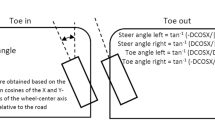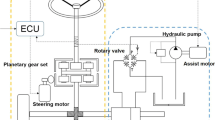Abstract
As the important performance of automobile, the vehicle handling stability has always been the focus of the research. The steering-by-wire (SBW) system is a major innovation to the traditional steering system, which brings new challenges to the research on the vehicle handling stability. In order to improve the vehicle handling stability and active safety of SBW, the multidomain model of SBW is established on the basis of proper simplification. A new vehicle handling stability evaluation method and its expression are proposed. The system parameters, vehicle handling and stability are studied by multidisciplinary design optimization (MDO), and selection of the system frequency response and time domain response characteristics have important influence on the key parameters analyzed in SBW system performance. The results show that the vehicle handling stability is significantly higher after the parameter optimization, which can be used to guide the parameters design and matching of the steering system.











Similar content being viewed by others
References
Miao L, He R, Xu J et al (2004) Summary of steaming electric steering technology. J Chang’an Univ 24(1):79–84
Zong C, Mai L, Bang X (2004) Car front wheel electronic steering system. China Mech Eng 6:1022–1025
Luo S, Shang G, Su Q (2006) Study on steering wheel force feedback control model of steering system. Automot Eng 28(10):914–917
Morgando A, Velardocchia M (2008) Steering feedback torque definition and generation in a steer by wire system. SAE Paper 200801—0498
Oh S-W, Chen H-C, Yun S-C et al (2004) The design of a controller for the steer-by-wire system. JSME Int Ser C 47(3):896–907
Yang S, Den C, Ji X et al. (2007) Research on road feeling control strategy of steer-by-wire. SAE Paper, 2007-01-3652
Wang N, Shi J, Li G (2015) Study on simulation of road sense of automobile wire steering system. Agric Equip Veh Eng 53(11):7–11
Kazemi R, Janbakhsh AA (2010) A nonlinear adaptive sliding mode control for vehicle handling improvement via steer-by-wire. Int J Automot Technol 11(3):345–354
Yu L, Lin Y, Shi G (2008) Study on dynamic model of wire-steering system. Comput Simul 25(6):251–253
Sun Y (2009) Design of wire-steering system and its characteristics. Xihua University, Chengdu
Yang T (2015) A new control framework of electric power steering system based on admittance control. IEEE Trans Control Syst Technol 23(2):762–769
Wu X, Ye C, Xu M, Kakogawa A (2016) Two port network based bilateral control of a steer-by-wire system. Int J Automot Technol 17(6):983–990
Jang B, Kim JH, Yang SM (2016) Application of rack type motor driven power steering control system for heavy vehicles. Int J Automot Technol 17(3):409–414
Liu Y (2005) SBW system research. Wuhan University of Technology, Wuhan
Guo K (1991) Vehicle maneuvering dynamics. Ji Baan Science and Technology Press, Changchun
Lee J, Chang S, Kim K, Jang B et al (2017) Steering wheel torque control of steer-by-wire system for steering feel. SAE Technical Paper 2017-01-1567
Dang J, Chen H, Gao B, Li Q, Li M (2014) Optimal design of on-center steering force characteristic based on correlations between subjective and objective evaluations. SAE Paper No. 2014-01-0137
Ljungberg M, Nybacka M, Gil Gómez G, Katzourakis D (2015) Electric power assist steering system parameterization and optimisation employing computer aided engineering. SAE Paper No. 2015-01-1500
Yun JN, Su J, Kim YI, Kim YC (2013) Robust disturbance observer for two-inertia system. IEEE Trans Ind Electron 60(7):2710–2770
Nybacka M, He X, Su Z, Drugge L, Bakker E (2014a) Links between subjective assessments and objective metrics for steering, and evaluation of driver ratings. Veh Syst Dyn 52(1):31–50
Nybacka M, He X, Gil Gómez GL, Bakker E, Drugge L (2014b) Links between subjective assessments and objective metrics for steering. Int J Automot Technol 15(6):893–907
Chen H, Chen L, Wang J (2010) Study on performance optimization and parameters of electric power steering system. Mech Sci Technol 29(2):146–152
Baxter J (1988) Analysis of stiffness and feel for a power-assisted rack and pinion steering Gear. SAE Paper, No. 880706
Chen JS (1998) Control of electric power steering systems. SAE Paper, No. 981116
Hu S (2003) The principle of automatic control, 4th edn. Science Press, Beijing
Chabaan RC, Wang LY (2001) Control of electrical power assist systems: \(\text{ H }\infty \) design, torque estimation and structural stability. JSAE Rev 22(4):435–444
Aly B, Jeff Z, Farhad B, et al. Modeling and analysis of an electric power steering system. SAE Paper:1999:1999-01-0399
Wang W, Yun H (2014) Electric power steering system parameters research and optimization design. J China Constr Mach 12(1):28–33
Luo J (1990) Introduction to system sensitivity theory. Northwestern Polytechnical University Press, Xi’an
Acknowledgements
The study is supported by the Natural Science Foundation of Zhejiang Province, China (Grant No. LY15E050023), and National Natural Science Foundation of China (Grant Nos. 51405117, 51675148, U1509203, U170920062).
Author information
Authors and Affiliations
Corresponding author
Rights and permissions
About this article
Cite this article
Chen, H., Chen, X., Chen, C. et al. Multidisciplinary design optimization for vehicle handling stability of steering-by-wire system. J Supercomput 75, 2964–2985 (2019). https://doi.org/10.1007/s11227-017-2208-2
Published:
Issue Date:
DOI: https://doi.org/10.1007/s11227-017-2208-2




